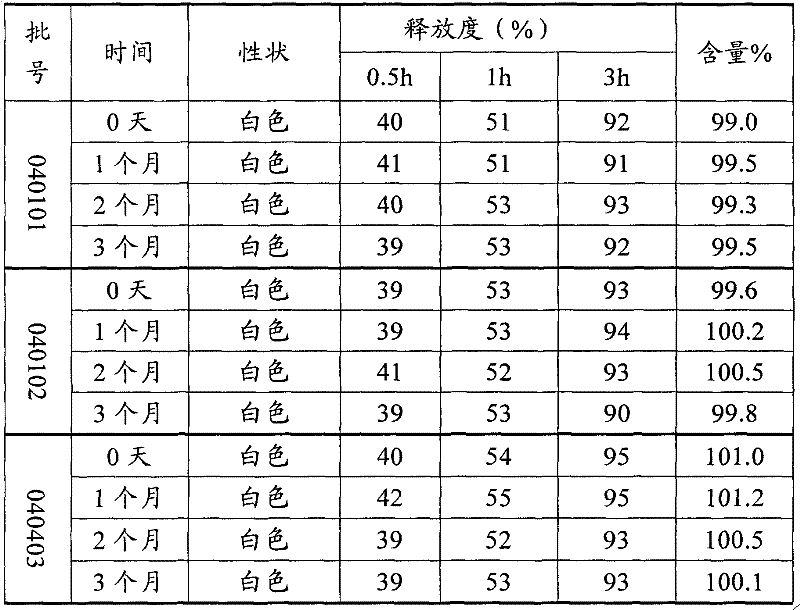Potassium citrate sustained release tablet and preparation method thereof
A technology of potassium citrate and sustained-release tablets, which is applied in pharmaceutical formulations, medical preparations with inactive ingredients, and medical preparations containing active ingredients, etc., can solve problems such as hidden dangers in product quality control and large measurement errors, and achieve Stable and controllable quality, improved release, and obvious slow-release characteristics
- Summary
- Abstract
- Description
- Claims
- Application Information
AI Technical Summary
Problems solved by technology
Method used
Image
Examples
Embodiment 1
[0051] Prescription optimization: Based on the Urocit-K formulation and its stability test results, the dosage of the sustained-release matrix in the formulation is screened, so as to more effectively control the release of the drug in the sustained-release tablet to improve the sustained-release tablet 3 hours release.
[0052] The preparation process of sustained-release tablets is as follows:
[0053] (1) Mix and crush potassium citrate crude drug with 2 / 3 prescription amount of micro-powdered silica gel, pass through an 80-mesh sieve, and set aside;
[0054] (2) Weigh the above-mentioned mixture of potassium citrate and micro-powdered silica gel and glyceryl behenate in a total mixer and mix for 10 minutes;
[0055] (3) Add the mixture in step (2) to a jacketed heating pot, adjust the temperature to a material temperature of 80-90°C, stir slowly, and melt for 30 minutes;
[0056] (4) After cooling to room temperature, add the prescribed amount of microcrystalline cellulose, stir ev...
Embodiment 2
[0066] Further optimization of the prescription: In order to further adjust the release rate, it is planned to add crospovidone in the melt granulation step on the basis of the prescription 2.
[0067] The sustained-release tablet sample was prepared according to the preparation process described in Example 1 and the release test was performed. The results are shown in Table 2.
[0068] Table 2 Composition and release results of each prescription
[0069] Prescription 2a
[0070] According to the results of prescription screening, the addition of a certain amount of crospovidone further improved the 3-hour release of the sustained-release tablet. When the mass ratio of glyceryl behenate to crospovidone was 2:1 (that is, the prescription 2c), the result of release is the best.
Embodiment 3
[0072] Selection of preparation process parameters: The melting point of the sustained-release base glycerol behenate is 75-80℃, and the melting and heating temperature recommended by the auxiliary material manufacturer is 80-85℃. Considering that different heating temperatures for melt granulation may lead to differences in the molecular arrangement of the sustained-release material, which affects the release rate, three heating temperatures are initially set: 80°C, 90°C, and 100°C, according to prescription 2c and Example 1. The preparation method prepared samples of sustained-release tablets and tested the release degree. The results are shown in Table 3.
[0073] Table 3 Heating temperature and release results of melt granulation
[0074]
[0075] It can be seen from the above results that there is no significant difference in the release degree of the three samples. From the aspects of energy efficiency and equipment parameter control error, it is preferable to set the heating...
PUM
 Login to View More
Login to View More Abstract
Description
Claims
Application Information
 Login to View More
Login to View More - R&D
- Intellectual Property
- Life Sciences
- Materials
- Tech Scout
- Unparalleled Data Quality
- Higher Quality Content
- 60% Fewer Hallucinations
Browse by: Latest US Patents, China's latest patents, Technical Efficacy Thesaurus, Application Domain, Technology Topic, Popular Technical Reports.
© 2025 PatSnap. All rights reserved.Legal|Privacy policy|Modern Slavery Act Transparency Statement|Sitemap|About US| Contact US: help@patsnap.com


